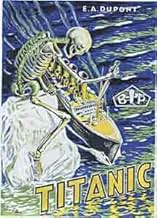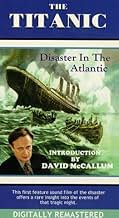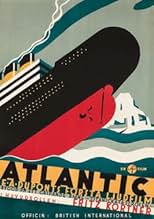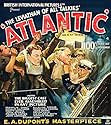On its maiden voyage in April 1912, the supposedly unsinkable RMS Titanic hits an iceberg in the Atlantic Ocean.On its maiden voyage in April 1912, the supposedly unsinkable RMS Titanic hits an iceberg in the Atlantic Ocean.On its maiden voyage in April 1912, the supposedly unsinkable RMS Titanic hits an iceberg in the Atlantic Ocean.
- Director
- Writers
- Stars
Gordon James
- Capt. Collins
- (as Sydney Lynn)
- Director
- Writers
- All cast & crew
- Production, box office & more at IMDbPro
Featured reviews
I was very surprised that I found this 1929 film on YouTube today.. I had no idea it existed and I was excited to see a talking picture made only a decade and a half after the disaster. However, my excitement turned out to be rather muted, as instead of having a grand scope (as ANY picture about the Titanic should have), it looks amazingly claustrophobic. Despite the ship having about 3300 folks aboard (counting crew and passengers), you mostly see scenes with a small handful of folks in them!! I think this is for two reasons. First, the film was obviously made on the cheap. Second, 1929 was the first year for sound pictures in the UK and like the earlier American films of 1927-28, the sound technology was primitive and they had no idea how to film large rooms full of people. Instead, folks had to stand around hidden microphones and talk...which seems unnatural when you see such movies.
As for the title, apparently the White Star Line had a lot of nerve and wouldn't allow the studio to use the name 'Titanic'. I am no barrister, so I have no idea about British law, but this seems more a ploy by White Star than a legitimate case where a copyright or trademark is involved. The sinking of the Titanic was a historical event and mentioning this and the ship's name seem reasonable...and I am not sure why the studio caved and named the movie 'Atlantic' instead of 'Titanic'...but they did.
One thing that was bad about the movie but isn't the filmmakers' fault is that the print is rather jerky and it jiggles a bit. You probably won't need Dramamine to watch the picture, but it is noticeable and annoying.
Another thing to note is that there apparently were several versions of the movie. In the earliest days of sound, they studios had no idea how to dub films into other languages...so they filmed multiple versions in various languages. Laurel & Hardy did this, the Bela Lugosi version of "Dracula" has another version starring a Mexican count and with "Atlantic", they filmed it in German, English AND as a silent (as most theaters didn't have the technology to play sound films yet). And, after finishing the filming, the film was re-cut and French language scenes were added. I saw the English language version...and have no idea if these other versions even exist today nor where you can find them if they do exist.
The movie is odd in that it just begins on the ship in a small drawing room just before the ill-fated crash. I checked...the print I saw WAS the entire 90 minute picture and the normal introduction apparently just wasn't made. This provided little in the way of suspense and over an hour of the film consists of what happens after the ship collides with an iceberg. And, since it was made with very few extras and cast, the whole thing seems a bit small and anticlimactic. But I do cut the film some slack because of when it was made....expecting the same spectacle as in the Nazi propaganda film "Titanic" (1943) or "A Night to Remember" (1958) or "Titanic" (1997) would be ridiculous. Cramped productions were certainly the norm until about 1930-31....and, in hindsight, it might have worked better had they just waited a year or so to make the movie. Additionally, the film lacks reasonably well developed characters and even for 1929, it was a bit of a disappointment in this regard. So, overall it's a very mixed bag for 1929...and a film that must have impressed back in the day but which became quickly dated as well. Mostly of value to the curious and film historians. I give it a 5 because it is watchable and some of the scenes were well made...but overall, it is disappointing and cramped!
As for the title, apparently the White Star Line had a lot of nerve and wouldn't allow the studio to use the name 'Titanic'. I am no barrister, so I have no idea about British law, but this seems more a ploy by White Star than a legitimate case where a copyright or trademark is involved. The sinking of the Titanic was a historical event and mentioning this and the ship's name seem reasonable...and I am not sure why the studio caved and named the movie 'Atlantic' instead of 'Titanic'...but they did.
One thing that was bad about the movie but isn't the filmmakers' fault is that the print is rather jerky and it jiggles a bit. You probably won't need Dramamine to watch the picture, but it is noticeable and annoying.
Another thing to note is that there apparently were several versions of the movie. In the earliest days of sound, they studios had no idea how to dub films into other languages...so they filmed multiple versions in various languages. Laurel & Hardy did this, the Bela Lugosi version of "Dracula" has another version starring a Mexican count and with "Atlantic", they filmed it in German, English AND as a silent (as most theaters didn't have the technology to play sound films yet). And, after finishing the filming, the film was re-cut and French language scenes were added. I saw the English language version...and have no idea if these other versions even exist today nor where you can find them if they do exist.
The movie is odd in that it just begins on the ship in a small drawing room just before the ill-fated crash. I checked...the print I saw WAS the entire 90 minute picture and the normal introduction apparently just wasn't made. This provided little in the way of suspense and over an hour of the film consists of what happens after the ship collides with an iceberg. And, since it was made with very few extras and cast, the whole thing seems a bit small and anticlimactic. But I do cut the film some slack because of when it was made....expecting the same spectacle as in the Nazi propaganda film "Titanic" (1943) or "A Night to Remember" (1958) or "Titanic" (1997) would be ridiculous. Cramped productions were certainly the norm until about 1930-31....and, in hindsight, it might have worked better had they just waited a year or so to make the movie. Additionally, the film lacks reasonably well developed characters and even for 1929, it was a bit of a disappointment in this regard. So, overall it's a very mixed bag for 1929...and a film that must have impressed back in the day but which became quickly dated as well. Mostly of value to the curious and film historians. I give it a 5 because it is watchable and some of the scenes were well made...but overall, it is disappointing and cramped!
How interesting that E.A. Dupont who created one of germany's most memorable silent films (VARIETY) also helmed one of England's first talkies. Obviously he was uneasy with the medium of talking pictures, note how the first 6 minutes of this film is entirely visual. Most of the cast had stage experience, you can tell because they over-exaggerate their lines and cannon out the words like they were playing to the back row. Still this is a well paced dramatic film and the final few minutes have an impact that can stand on their own alongside the later versions, TITANIC and A NIGHT TO REMEMBER. (I am deliberately excluding James Cameron's film with its budget that would have fed a 3rd World country for 10 years and its plethora of computer FX.)
Yes I know "talkies" had just been invented for the cinema 2 years earlier when this was produced in 1929 but this film showed that much had to learnt about the art of producing films.It comes over as a filmed "hammy" stage play with the actors melodramatically enunciating their lines,rolling their eyes, using too many pregnant pauses and using gestures more appropriate to silent cinema, which I suppose was normal during the process of educating them to appear more naturalistic on screen.The gaps between lines spoken should have been tightened up during editing as it considerably slows the film.It is now only of interest for Titanic buffs who want to see an early example of this marine accident on film.In next chronological order they could see "Titanic" (1953) A Night to Remember (1958)"Titanic (1997), to see how the cinema's depiction of this tragedy as evolved over the years.There have been many documentaries and TV films made including the atrocious "SOS Titanic" (1979) On my version which is a DVD, David McCallum gives the introduction.It was he who played Harold Bride Marconi's junior wireless operator in "A Night to Remember"(still the best feature film - please read my "Tribute to Walter" comments on IMDb under Howard Morley.demon.co.uk)and gave the commentary on the series of 4 videos entitled "End of a Dream" so he was well qualified to give the narration.Of more interest I found was a recording accompanied by actual photos of the 1912 US Senate hearing which is also on the DVD.Actors speak the actual words spoken by Lightoller 2nd officer, J Bruce Ismay,Managing director of White Star, Harold Bride and others including Gloria Stewart (The "old Rose" in Titanic 1997) whose voice is used for one of the first class women survivors.
I purchased this film on DVD to add to my collection of Madeleine Carroll films, and although the stunningly beautiful actress does not have a tremendous amount of screen time, I was not disappointed in the final product. I've never particularly cared for disaster films, and the Cameron blockbuster of a few years ago left me decidedly cold, as it were. Not being an expert on the events surrounding the sinking, I was still quite sure that this mega-hit had little relation to what actually transpired on that fateful night. In any event, I am convinced that the film under review is of greater historical accuracy, and unlike the other reviewers, I am not particularly discouraged to discover that a film made almost 80 years ago is not quite as "spiffy" as more recent products. At the very least, films of this type should be regarded as valuable documents of the ways things were done in the not too distant past, and when you realize that "Atlantic" was made a mere 17 years after the Titanic went down, that is all the more reason to cherish it as an invaluable time capsule of a significant event in the annals of the 20th century that still apparently fascinates a great many people.
As far as the individual performances are concerned, I thought that the players effectively conveyed the starkness of the dilemma the doomed passengers were facing, especially the futility of those remaining men who had hope no hope of salvation, the end being only a matter time. Of particular note was the abrupt contrast between the gay frivolity that permeated the mood immediately before the bad news was conveyed by Lanchester and what immediately followed. Add to that Monica's frantic separation from her husband, as she was literally dragged on to the hanging lifeboat, was quite poignant, made all the more so when the news that she was pregnant became known later.
For those interested in a well made vintage film that provides a fascinating look at a sensational event with which practically everyone alive has at least some inkling of, I highly recommend this film. (And there's the added bonus of a very young Madeleine Carroll to feast your eyes on).
As far as the individual performances are concerned, I thought that the players effectively conveyed the starkness of the dilemma the doomed passengers were facing, especially the futility of those remaining men who had hope no hope of salvation, the end being only a matter time. Of particular note was the abrupt contrast between the gay frivolity that permeated the mood immediately before the bad news was conveyed by Lanchester and what immediately followed. Add to that Monica's frantic separation from her husband, as she was literally dragged on to the hanging lifeboat, was quite poignant, made all the more so when the news that she was pregnant became known later.
For those interested in a well made vintage film that provides a fascinating look at a sensational event with which practically everyone alive has at least some inkling of, I highly recommend this film. (And there's the added bonus of a very young Madeleine Carroll to feast your eyes on).
Try to focus on the actual disaster, having just occurred sixteen, seventeen years earlier than when this film came out, and see what was known, what was rumored, what was accepted to have happened, and not dwell on the rawness of the film-making.
Well, that was near impossible to do, right up to the end. I thought Alfred Hitchcock's "Murder" (which came out about the same time) was about one of the most experimental films I had ever seen, but I think this one might outdo it.
The sound is awful, but a silent film done well, or a totally non-talking piece, such as what Laurel & Hardy did, could be just as entertaining, if it has a good story structure. Well, this movie can't claim that either.
Hands down, that mother constantly weeping about her nerves and pressing the hankie to her mouth because she has learned her husband was cheating on her was a constant irritation. Oh, if only she had gone down with the ship!
As with the Barbara Stanwyck-Clifton Webb-Robert Wagner 1953 version, this film delved into adultery. No idea why that theme was always attached to the sinking.
Franklin Dyall, father of the impressive Valentine Dyall (best known for Doctor Who appearances to the American audience) strived for his best Lionel Barrymore, but was outdone in two seconds by Elaine Terriss as his wife, in her brief appearance when she learned he wouldn't enter a lifeboat.
Even to a novice like me, there clearly was a problem with direction; with how sound on the film would sound as opposed to dialogue delivered on stage, as well as to how it was recorded.
I was dumbstruck by Dyall questioning Manchester "you seem to think this is damn serious?"
Wasn't it a really big deal when Clark Gable said 'Damn' in "Gone With the Wind"?
Oh, he was a MAJOR star. A major star doing that. I see.
And I look at most depictions of Blacks in these old films as being historical, but to put a pair of Blacks on this thing just to have them shot because they try to storm the lifeboats I'm sure didn't help race relations back then. While these were actual Black people and not blackface, I tend to try to think how much the performers enjoyed working and getting to dive off the boat like that.
Other than the 1912 version with actual Titanic survivor Dorothy Gibson in it, wearing the outfit she was wearing when she was rescued, this stands as about the earliest version of the disaster. No idea what that Italian 1915 film could be, if it is even based on the ship-in-question.
This film was to be titled Titanic, but outrage and sensitivity toward the event, which again, had just occurred sixteen years earlier, saw a retitling, and it became "Atlantic".
The version I have on tape has a reworked title with the old stock footage of the doomed liner and it is now titled "Titanic". As a film, I would have preferred the original title to be present.
As it is, scenes of the film's disaster, and for that matter still shots I have seen from this movie, did not match up to what was present here, so I'm not sure what is going on as far as editing goes.
There are other Titanic movies depicting the ship to check out, but if you are a buff, like me, you enjoy checking out as many different versions of the Titanic that you can find.
Of all I have seen now (S.O.S. Titanic, 1943 German version, Cameron's Titanic, Night To Remember, George C. Scott-Catherine Zeta Jones, 1953, Unsinkable Molly Brown, even have the recent musical soundtrack), this one has to be the worst.
Well, that was near impossible to do, right up to the end. I thought Alfred Hitchcock's "Murder" (which came out about the same time) was about one of the most experimental films I had ever seen, but I think this one might outdo it.
The sound is awful, but a silent film done well, or a totally non-talking piece, such as what Laurel & Hardy did, could be just as entertaining, if it has a good story structure. Well, this movie can't claim that either.
Hands down, that mother constantly weeping about her nerves and pressing the hankie to her mouth because she has learned her husband was cheating on her was a constant irritation. Oh, if only she had gone down with the ship!
As with the Barbara Stanwyck-Clifton Webb-Robert Wagner 1953 version, this film delved into adultery. No idea why that theme was always attached to the sinking.
Franklin Dyall, father of the impressive Valentine Dyall (best known for Doctor Who appearances to the American audience) strived for his best Lionel Barrymore, but was outdone in two seconds by Elaine Terriss as his wife, in her brief appearance when she learned he wouldn't enter a lifeboat.
Even to a novice like me, there clearly was a problem with direction; with how sound on the film would sound as opposed to dialogue delivered on stage, as well as to how it was recorded.
I was dumbstruck by Dyall questioning Manchester "you seem to think this is damn serious?"
Wasn't it a really big deal when Clark Gable said 'Damn' in "Gone With the Wind"?
Oh, he was a MAJOR star. A major star doing that. I see.
And I look at most depictions of Blacks in these old films as being historical, but to put a pair of Blacks on this thing just to have them shot because they try to storm the lifeboats I'm sure didn't help race relations back then. While these were actual Black people and not blackface, I tend to try to think how much the performers enjoyed working and getting to dive off the boat like that.
Other than the 1912 version with actual Titanic survivor Dorothy Gibson in it, wearing the outfit she was wearing when she was rescued, this stands as about the earliest version of the disaster. No idea what that Italian 1915 film could be, if it is even based on the ship-in-question.
This film was to be titled Titanic, but outrage and sensitivity toward the event, which again, had just occurred sixteen years earlier, saw a retitling, and it became "Atlantic".
The version I have on tape has a reworked title with the old stock footage of the doomed liner and it is now titled "Titanic". As a film, I would have preferred the original title to be present.
As it is, scenes of the film's disaster, and for that matter still shots I have seen from this movie, did not match up to what was present here, so I'm not sure what is going on as far as editing goes.
There are other Titanic movies depicting the ship to check out, but if you are a buff, like me, you enjoy checking out as many different versions of the Titanic that you can find.
Of all I have seen now (S.O.S. Titanic, 1943 German version, Cameron's Titanic, Night To Remember, George C. Scott-Catherine Zeta Jones, 1953, Unsinkable Molly Brown, even have the recent musical soundtrack), this one has to be the worst.
Did you know
- TriviaThe White Star Line forbade the production company from referring to the ship in this film as The Titanic.
- GoofsSet in 1912, he women's hairstyle and dresses are from 1929.
- Alternate versionsReleased with separate English, French and German soundtracks.
- ConnectionsAlternate-language version of Atlantik (1929)
- SoundtracksWalking With Susie
(uncredited)
Written by G.H. Elliott
Played by the ship's band as Larry and Monica enter the Smoking Room.
Details
- Release date
- Country of origin
- Language
- Also known as
- Titanic: Disaster in the Atlantic
- Filming locations
- Production company
- See more company credits at IMDbPro
Box office
- Budget
- £2,000 (estimated)
- Runtime
- 1h 30m(90 min)
- Color
- Aspect ratio
- 1.20 : 1
Contribute to this page
Suggest an edit or add missing content



































